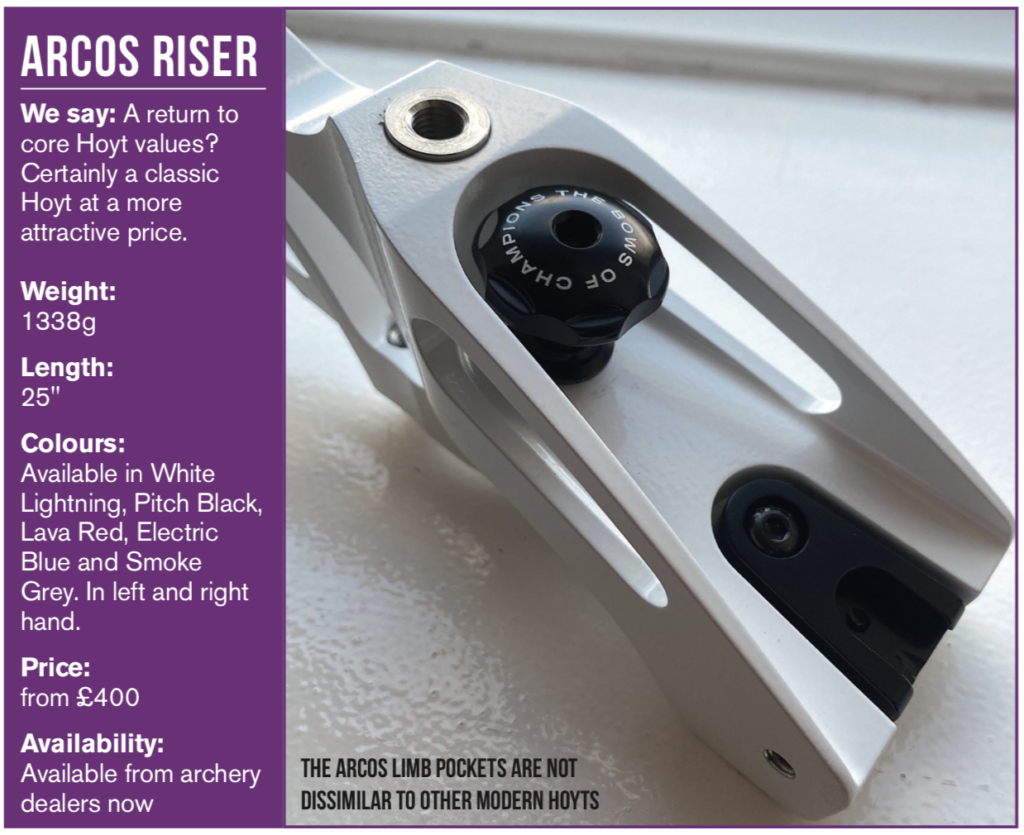A trio of mid-price offerings from Hoyt turns back the clock.
There is a feeling among many recurve archers that there isn’t much new under the sun.

The incremental improvements in materials science and computer-aided design have definitely resulted in improvements to a majority of archery equipment, and the continual improvements in quality control and consistency when manufacturing have benefitted the archer and consumer all over the world.
But the relatively strict definition of what a recurve bow (or barebow) is means that a lot of the innovation is very tiny and incremental, or might only be valuable to the elite of the elite.
The long lineage of ILF Hoyt risers, before the focus on Formula, means that some of their most lauded models are now long in the past.
Many regard the GMX (Gold Medalist Xtreme) of around ten years ago as the ‘reference’ riser that defined a design around the world (and in the Bow office) – partly because it was used to win a number of Olympic medals.
Despite its slightly unforgiving nature (and the shim limb adjustment) the GMX’s balance and geometry are considered close to the ideal for many, and it has become the basis – shall we say – for many other East Asian-manufactured risers.
Hoyt recurve design engineers moved on to the Formula series, but multiple previous designs of the 90s and 00s, using the ‘original’ Earl Hoyt geometry, still stand the test of time.
Both these newer risers use that same geometry. The Arcos, supplied to us here in a brilliant glossy white, appears to be a descendent of another almost equally lauded riser; the Avalon from the mid-1990s, albeit with modern limb pockets that look a lot more like its newer offerings, like the top-end Xceed.

It comes in at a close-to-standard 1388g, and has a chunkier, more brutal feel about the lines. It is priced at the upper intermediate end of the market.
The Xakt is the newest entry level model from Hoyt. At 1088g, it’s relatively light by modern riser standards and should work well for beginners and juniors. It has a slight deflex, which will help with the forgiveness. Design-wise, it is definitely in the line of the classic Excel and Horizon models.
Like the Arcos, it comes with lateral limb adjustment, locking tiller bolts, and an extended clicker plate. Also like the Arcos, it comes with the modern high, flat, sharp-edged Hoyt rubberised grip that has become standard across their portfolio.
This grip has polarised some and may not suit all hand shapes; luckily there are some excellent aftermarket options. The Xakt also comes with a prominent ‘Made in the USA’ sticker.

The Arcos has a extra rear bushing at the rear for damping or weights or both. Both risers appear to use the same hardware for locks, tillers and bushings.
On the backyard boss, both risers performed solidly. Both were notably easy to get a basic tune together, the lateral limb adjustment particularly easy out of the box. The weightier Arcos delivered a rigid shot with good feedback, with the Xakt a solid and ‘clean’ shot, slightly less ‘dead’.
The Xakt’s balance felt particularly good with a standard heavyweight stabiliser setup, surprising to me considering its lightness. (Unfortunately due to lockdown restrictions it wasn’t possible to conduct a scheduled test at distance).
Both improved (from this shooter’s perspective) with some dampeners; a Doinker A-Bomb in place up top gave both of them a more modern shot feeling.
Both risers come with some case candy: a sticker, a keychain, allen keys, a Hoyt Super Rest, and a short manual, as well as the usual riser bag. The finish and detailing appears as good as the top-end Hoyt risers.
Both risers are available in left or right hand in the same set of anodised colours, all matt finish apart from the glossy ‘White Lightning’. The differences in price between the two are harder to quantify in terms of what you are getting for your money.
I might hazard a guess that the Xakt is 3-axis machined for (much) faster manufacturing and the more complex Arcos is 5-axis, but that would be speculating.
The Arcos and the Xakt are the premium beginner and intermediate models which are now competing with increasingly high quality risers made in China, often using similar CAD/CAM machining processes.
But for those looking for an authentic (or even ‘classic’) Hoyt experience, with updated limb pockets and improved detailing all round, you will be well served with either of these excellent new risers, which may only be missing a couple of the bells and whistles of the very, very expensive premium risers.
The essential DNA of both of them took archers to the Olympic Games. They just might be able to do it for you, too.

